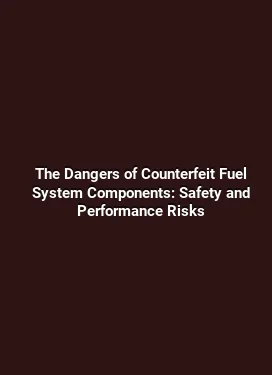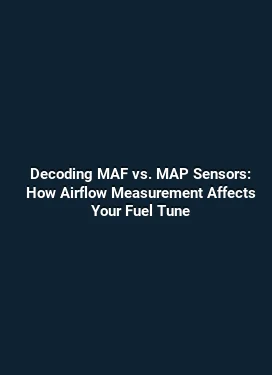The Role of Fuel Rails and Regulators in Maintaining Consistent Pressure for Boosted Engines
In modern performance tuning, the ability to sustain predictable fuel pressure under boost is a cornerstone of reliable power delivery. Boosted engines, whether using turbochargers or superchargers, demand precise fuel metering to match the rapid air charge entering the cylinders. At the heart of this system lies the fuel rail and its pressure regulator, components that couple fuel storage with metering to ensure the injectors deliver the correct amount of fuel at the right time. This article delves into how fuel rails and regulators work together to maintain pressure stability, the factors that influence them, and practical steps to optimize their performance in a street-driven or track-ready setup.
Foundations of Fuel Delivery in Boosted Applications

Understanding the fuel rail and its role

The fuel rail acts as a high-pressure manifold that distributes fuel to each injector. In a boosted engine, the rail must withstand elevated pressures generated by the fuel pump and regulated by the system. A well-designed rail maintains consistent fuel pressure across all injectors, even as engine speed and load change. This uniformity minimizes timing discrepancies between cylinders and reduces the risk of lean or rich conditions that can undermine performance or reliability.
Key characteristics of an effective fuel rail include material strength, internal passage sizing, port alignment with the injector seats, and mounting stability. In high-boost scenarios, rails may incorporate larger internal diameters or multiple independent passages to minimize pressure drop along the length of the rail. The choice between single-pass and multi-pass rail designs can influence how pressure responds during sudden throttle inputs or shifts in boost pressure.
Role of the fuel pressure regulator
The regulator serves as the pressure control valve that maintains a target fuel rail pressure by balancing the flow of fuel back to the tank with the demand from the injectors. In boost-conscious systems, regulators must react quickly to changes in boost pressure and engine demand to prevent pressure spikes or drops that could affect injector performance. Some systems use an external rising-rate regulator that increments the fuel pressure in proportion to boost, while others rely on rail-mounted regulators that modulate in step with the base system design.
Regulators influence overall fuel system behavior, including fuel pulsation, flow stability, and response at idle versus high-load conditions. They often pair with a return-line design or a returnless setup, each with distinct implications for pressure stability and thermal management. The regulator’s spring rate, flow path geometry, and seating precision are all critical to achieving consistent pressure across the operating envelope.
Pressure Consistency: Why It Matters Under Boost
Impact on injector performance and spray pattern
Injectors rely on a stable pressure differential (rail pressure minus manifold pressure) to atomize fuel consistently. Fluctuations in rail pressure translate to variations in injector flow, altering the air-fuel ratio. In forced-induction engines, small deviations can have outsized effects due to the compressed air charge, increasing the likelihood of knock, misfire, or elevated exhaust temperatures. Consistent rail pressure helps maintain predictable spray patterns, particularly important for multi-hole injectors that demand uniform fuel distribution across each cylinder.
Designers often specify rail pressure targets that align with injector flow rates and the engine’s torque curve. When pressure stability is achieved, the engine experiences smoother power delivery, better throttle response, and more repeatable performance on different driving conditions.
Boost pressure dynamics and rail behavior
Boost pressure introduces a dynamic loading condition on the fuel system. As boost rises, the effective pressure the injectors must overcome increases, potentially reducing relative pressure seen by the injectors if the regulator cannot compensate quickly enough. A well-tuned system employs a regulator and rail geometry that respond rapidly to boost fluctuations, ensuring the rail pressure tracks the demand without lag. This is particularly crucial during rapid transitions, such as throttle transitions on the track or in aggressive gear shifts on the street.
Design Considerations for Rails and Regulators in Boosted Setups
Rail sizing, material, and end-fitment
Rail sizing must balance volume and responsiveness. A larger internal volume can dampen pressure oscillations but may introduce a slower response to sudden demand changes. Conversely, a compact rail may react quickly but be more susceptible to pressure dips during high-load events. Materials like aluminum alloys provide stiffness and corrosion resistance, while dual-wall or cross-drilled rails can help manage heat and reduce the potential for fuel temperature rise that could affect vaporization behavior.
End-fitment considerations include injector compatibility, O-ring sealing reliability, and mounting robustness. Rails designed for high-flow applications may feature larger rail ports or multiple feed connections to keep flow unobstructed as boost and RPM rise. Proper alignment with injector nozzles and return lines reduces port-induced turbulence and helps maintain steady pressure across cylinders.
Regulator types and their behavior under boost
There are several regulator architectures to choose from, each with distinct response characteristics. Rising-rate regulators are prized for their ability to increase fuel pressure in step with boost, helping maintain a constant differential pressure across injectors. Fixed regulators, when paired with an appropriate pump and return flow strategy, can still deliver stable pressure if the system is tuned precisely for the engine’s operating range. The placement of the regulator—whether on the rail, in the fuel line near the tank, or integrated with the pump assembly—affects how quickly it can react to demand changes and how much heat is transferred to the fuel.
Practical Tuning Approaches for Consistent Rails Pressure
Calibration strategies and real-world testing
Effective calibration begins with establishing baseline pressure targets at idle, part-throttle, and wide-open throttle (WOT) across different RPM bands. A common approach is to map rail pressure against boost pressure to determine how aggressively the regulator must respond to maintain a stable differential. Engine dynamometer testing provides repeatable conditions to assess pressure stability, injector behavior, and fueling accuracy. On the road, data logging for rail pressure, boost, RPM, throttle position, and injector duty cycle helps identify transient spikes or dips that occur during gear changes or rapid acceleration.
Data-driven adjustments may involve tweaking regulator spring tension, calibrating pump pressure, or selecting an alternative rail with lower internal volume to reduce lag. It’s also important to monitor fuel temperature, as heat can affect density and pressure readings, especially on high-heat applications where the fuel is circulated near the exhaust system or turbo housing.
Fuel pump considerations and their relationship with rails
A reliable high-pressure fuel pump is a prerequisite for stable rail pressure in boosted engines. Pumps with insufficient headroom can struggle to maintain pressure under high boost, leading to pressure drop and inconsistent injector flow. Upgrades often involve a higher-capacity pump or a pump that provides a stable flow across the engine’s entire RPM range. In addition, ensuring that the supply line is free of restrictions and that the return path is unobstructed helps sustain steady rail pressure even during aggressive acceleration or track days.
Careful routing of fuel lines to minimize heat soak and vibration, along with robust electrical supply to the pump, reduces the risk of pressure instability caused by electrical resistance or fuel heating during long drives.
Common Challenges and How to Address Them
Pressure drop across long fuel lines and rail segments
As fuel travels through longer hoses or through a multi-rail configuration, pressure may decay due to friction losses. Mitigation strategies include selecting low-restriction lines, using appropriately sized hoses for the target flow, and employing rail designs that shorten the distance from the pump to the furthest injector. In some setups, splitting supply paths or using a parallel feed becomes advantageous to reduce the impact of line length on pressure stability.
Heat management and fuel integrity
Fuel temperature rise can alter density and change the pressure readings observed by the regulator. Thermal management practices, such as routing lines away from heat sources, using insulated portions of pipe, and choosing fuels with favorable temperature stability characteristics, support more stable pressure behavior. In high-heat environments, cooling strategies for the fuel system, including heat shields or fuel coolers, can be beneficial.
Upgrades and Maintenance for Long-Term Stability
Choosing compatible components for a given power target
When increasing boost or fuel demands, upgrading the rail to a higher-capacity model and selecting a regulator with a suitable spring rate and flow path can preserve pressure stability. Compatibility with injectors, pumps, and the vehicle’s ECU or engine management system is essential to avoid mismatches that could cause fueling errors or drivability issues. It is wise to verify fuel pressure at idle, at steady cruise, and during elevated load to ensure consistent performance across the operating range.
Inspection, wear, and preventive care
Regular inspection of the fuel rail for signs of leaks, corrosion, or physical damage is important. Injector seating surfaces should be checked for wear, and O-rings should be replaced if there are signs of leakage. Regulators should be tested for response speed and seating integrity; a regulator that sticks or leaks will compromise rail pressure. Record-keeping of maintenance events helps anticipate when a component may need replacement due to wear or aging, especially in motorsport environments where components endure harsh operating conditions.
Synergy with Other Systems and Real-World Scenarios
Interaction with intake and exhaust systems
The fuel delivery system does not operate in isolation. The intake manifold design, turbocharger or supercharger configuration, and the exhaust backpressure all influence the overall air-fuel dynamics. A properly tuned fuel rail and regulator should complement the intake and exhaust characteristics to deliver a smooth torque curve with minimal heat buildup and consistent combustion efficiency. For example, engines with variable geometry turbochargers may experience sharper boost transitions, making rapid-regulator response more critical for maintaining fueling stability.
Track-ready setups vs street configurations
Track-focused builds tend to prioritize rapid regulator response and low pressure drop, with rails designed to minimize velocity losses and reduce pulsations. Street-oriented configurations may emphasize freestyle fuel pressure consistency with emphasis on noise, emissions, and daily drivability. Regardless of application, the underlying principle remains: maintain a predictable rail pressure that matches the engine’s fuel demand profile under boost, without introducing transitional instability that can hamper performance or reliability.
Final Thoughts on Achieving Stable Fuel Pressure in Boosted Engines
Maintaining consistent pressure in the fuel rail is a multi-faceted challenge that requires careful selection of components, precise calibration, and ongoing monitoring. A well-matched rail and regulator combination that accounts for boost behavior, injector characteristics, and pump capacity leads to cleaner injector spray, steadier engine response, and enhanced performance across the RPM spectrum. Embracing a data-driven approach—backed by heat-aware fuel routing, robust electrical supply, and thorough dyno validation—helps build confidence in the boosted system and supports long-term reliability in demanding driving conditions.






